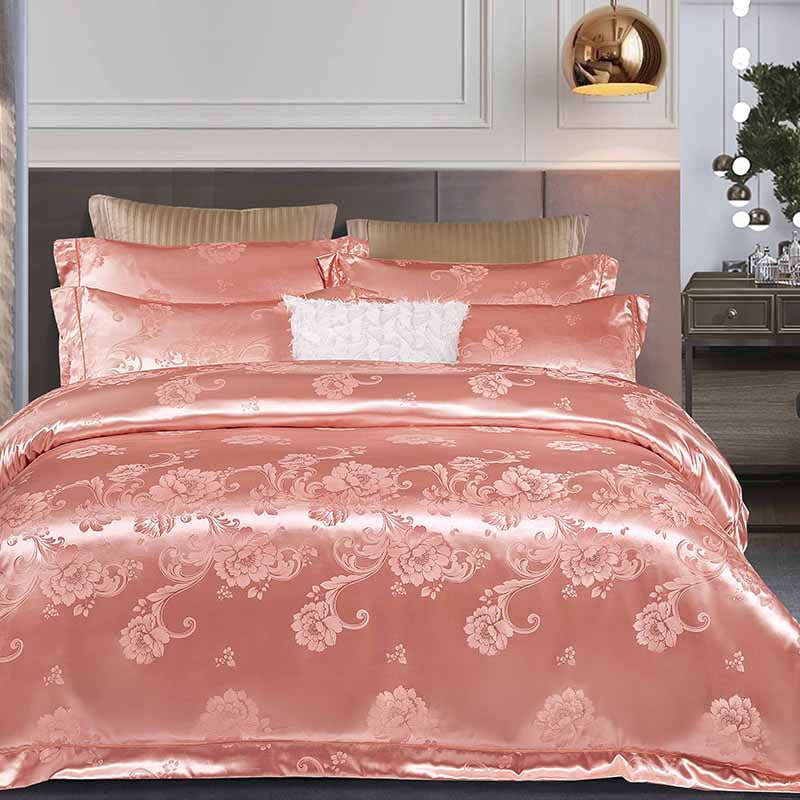What can we do to prevent jacquard duvet covers from shrinking after washing
To prevent jacquard duvet covers from shrinking after washing, you can implement the following strategies:
Pre-Shrinking the Fabric
Process: Before the fabric is cut and sewn into duvet covers, it can be pre-shrunk through a process called sanforization or controlled pre-washing. This involves washing the fabric in controlled conditions and then drying it. This step ensures that the fabric shrinks to its maximum potential before it’s turned into the final product.
Selection of Shrink-Resistant Fibers
Material Choice: Different fibers react differently to washing. For example, synthetic fibers like polyester and blends of polyester with cotton are less prone to shrinking compared to 100% cotton or linen. When choosing materials for jacquard duvet covers, consider using fibers that naturally resist shrinkage.
Treated Cotton: Cotton that has been mercerized or otherwise treated can be more resistant to shrinkage. Blending cotton with synthetic fibers can also maintain the natural feel while reducing shrinkage.
Proper Weaving Techniques
Tight Weave: The structure of the jacquard weave plays a crucial role in how the fabric behaves during washing. A tighter weave helps maintain the fabric’s integrity and reduces the likelihood of shrinkage. Ensuring that the weave is both tight and stable during production will help in preserving the fabric’s size and shape.
Advanced Weaving Technology: Utilizing modern weaving technologies that apply consistent tension and avoid unnecessary stretching of the fibers during production can further minimize potential shrinkage.
Fabric Treatments and Finishes
Chemical Treatments: Applying specific chemical treatments to the fabric can enhance its resistance to shrinkage. Resin finishes, for example, create a cross-linking effect within the fabric fibers, which helps maintain the original size and shape of the fabric even after washing.
Heat Setting: Another method is heat setting, where the fabric is subjected to a controlled heat treatment to stabilize the fibers and set them in place, reducing the likelihood of shrinkage.
Controlled Washing Conditions
Consumer Instructions: Provide clear washing instructions to your customers, recommending that the duvet covers be washed in cold water and on a gentle cycle. Heat is a primary cause of shrinkage, so advising against hot water washing is crucial.
Delicate Detergents: Suggest the use of mild detergents that are less likely to cause damage or stress to the fabric, thereby preserving its original dimensions.
Drying Techniques
Air Drying: Encourage air drying of jacquard duvet covers whenever possible. Air drying reduces the stress that heat from a dryer can place on the fabric, which is a common cause of shrinkage.
Low-Heat Machine Drying: If machine drying is necessary, recommend using a low-heat setting. High heat can cause the fibers to contract, leading to shrinkage. In some cases, using a tumble dryer on a cool setting with dryer balls can help maintain the fabric's fluffiness without excessive shrinkage.
Quality Control and Testing
Shrinkage Testing: Conduct thorough shrinkage tests during the product development phase. By simulating washing and drying conditions that customers will likely use, you can identify potential shrinkage issues before mass production.
Continuous Monitoring: Implement ongoing quality control checks during production to ensure that the shrinkage rates remain within acceptable limits.
By combining these strategies, you can effectively minimize shrinkage in jacquard duvet covers, ensuring that they retain their quality, appearance, and fit even after multiple washes. This approach not only enhances customer satisfaction but also reinforces the durability and premium quality of your products.
The Role of Jacquard Weave in Enhancing the Aesthetic Appeal of Duvet Covers
Jacquard weaving has long been celebrated for its ability to create intricate patterns and textures that elevate the visual appeal of textiles. In the realm of duvet covers, the Jacquard weave offers a unique combination of functionality and aesthetics, making it a preferred choice for those seeking to add sophistication and elegance to their bedding. This article delves into how Jacquard weaving enhances the aesthetic appeal of duvet covers, examining the intricacies of the weave, its impact on design, and its contribution to the overall bedroom ambiance.
Understanding Jacquard Weave
What is Jacquard Weaving?
Jacquard weaving is a highly complex technique that allows for the creation of intricate patterns directly into the fabric, rather than being printed or embroidered onto it. This method utilizes a special loom equipped with a Jacquard attachment, which controls each warp thread individually, enabling the weaving of detailed and elaborate designs.
Historical Significance:Developed in the early 19th century by Joseph Marie Jacquard, this weaving technique revolutionized textile manufacturing by allowing for the mass production of complex patterns. Over time, Jacquard weaving has become synonymous with luxury and high-quality textiles, particularly in home décor and bedding.
The Aesthetic Advantages of Jacquard Duvet Covers
Intricate Patterns and Designs:One of the most significant aesthetic advantages of Jacquard duvet covers is the ability to incorporate intricate, woven patterns that add depth and visual interest to the fabric. These patterns can range from simple geometric shapes to elaborate floral motifs, providing endless design possibilities.
Texture and Dimension:The Jacquard weave naturally adds texture to the fabric, creating a tactile dimension that enhances the overall sensory experience. This texture not only contributes to the duvet cover's visual appeal but also adds a layer of comfort, making the bedding more inviting.
Subtle Elegance:Unlike printed designs, which can sometimes appear flat, Jacquard patterns are woven into the fabric, giving them a subtle, elegant look. The interplay of light and shadow on the raised patterns adds a dynamic quality to the duvet cover, making it a focal point in any bedroom setting.
Versatility in Design:Jacquard duvet covers are versatile in design, available in a wide range of colors, patterns, and styles. Whether the décor is modern, traditional, or eclectic, there is a Jacquard duvet cover to complement it. The ability to customize patterns and colors further enhances the duvet cover's role in achieving a cohesive and aesthetically pleasing bedroom design.
Impact on Bedroom Ambiance
Creating a Luxurious Atmosphere:The inherent richness of Jacquard fabrics instantly adds a touch of luxury to any bedroom. The complex patterns and textures evoke a sense of sophistication, transforming the bedroom into a sanctuary of style and comfort.
Enhancing Visual Harmony:Jacquard duvet covers can help tie together various elements of a room's décor, such as curtains, upholstery, and carpets, creating a harmonious and cohesive look. The ability to match or complement other Jacquard fabrics in the room adds to the overall aesthetic balance.
Customization and Personalization:For those looking to personalize their space, Jacquard duvet covers offer numerous options for customization. From bespoke patterns to tailored color schemes, these duvet covers can be designed to reflect individual tastes and preferences, further enhancing the room's unique character.
By choosing a Jacquard duvet cover, homeowners can enjoy the perfect blend of beauty, comfort, and sophistication in their bedding.



 English
English Español
Español عربى
عربى
























 +86-159 5050 0822
+86-159 5050 0822 peter@rainbowhomefashion.com
peter@rainbowhomefashion.com No.199 Yimin Road, Dateng DIstrIct, Yancheng City. Jiangsu Province, China
No.199 Yimin Road, Dateng DIstrIct, Yancheng City. Jiangsu Province, China
